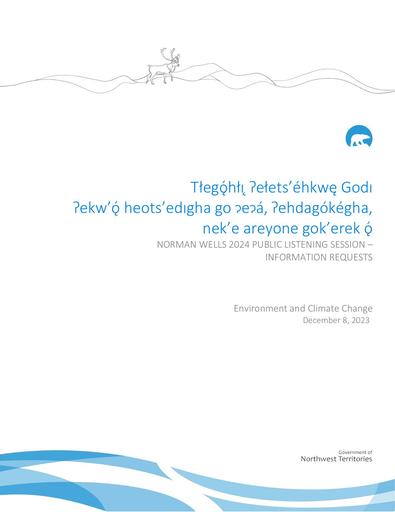pdf 23 -12-08 ECC Response to Information Request Round 1 Popular
By Catarina Owen 768 downloads
23-12-08 - ECC Response to Information Request Round 1.pdf

Summary of GNWT Environment and Climate Change IR 1 Responses
What are the impacts/predicted impacts of climate change of climate change in the Sahtú Settlement Area and on caribou and caribou habitat?
There are differences in the three types of caribou and their habitats in the Sahtú Settlement Area (SSA) but climate change is a threat to all three.
The SSA is expected to become warmer, with drier, longer growing seasons, shorter and warmer winters, and increased precipitation but also increased evaporation. This could lead to increased:
- Food and time to forage for caribou;
- Woody shrubs with less nutrition and harder for caribou to digest;
- Fires, intensity and longer fire seasons therefore decreased old growth forest and lichen;
- Slumping and degradation of vegetation and water quality;
- Parasites, diseases and insect harassment and also changes in types, frequency and distribution of new diseases and pests; and/or
- Freeze-thaw and rain on snow events, leading to increased energy use for caribou to access food.
How are climate change plans or policies addressing caribou? Other anticipated plans/policies?
Please see the Relevant Documents tabs in the Registry which includesÂÂ ÂÂ ECC-recommended documents. This, and the full ECC response, covers:
- Monitoring and Research
- Habitat Protection and Land-use Planning
- Harvest Management
- Indigenous Knowledge Integration
- Carbon Emission Reduction
- Education and Community Engagement
- Partnerships and Collaboration
- Climate-Resilience and Adaptation Strategies
What programs or supports are available to communities for adaptation or mitigation measures related to climate change or wildfire impacts on caribou?
- NWT Species Conservation and Recovery Fund
- The Aboriginal Fund for Species at Risk
- Agri-Food Funding
- Climate Change Preparedness for the North-Community Stream (provided by CIRNAC)
- Federal Support for NWT projects to improve infrastructure and wildfire protection
What adaptations or mitigations need to be planned in response to the predicted impacts?
The GNWT is:
- Implementing the 2019-2023 Climate Change Action Plan
- About to complete the first NWT Climate Risks and Opportunities Assessment (ROA) to identify the most concerning climate risks (and potential opportunities).
- Collaborating closely with the NWT Climate Change Council and the Government of Yukon and the Government of Nunavut, through the Pan-Territorial Adaptation Framework, to ensure that the National Adaptation Strategy (NAS) acknowledges the unique northern climate context. The Strategy was released by the federal government in June 2023.
- Working with other provinces on a Northern Approach to the implementation of the NAS to make sure funding and capacity to advance NWT climate adaptation priorities are available. The NWT Climate Change Council will inform opportunities for alignment in how the NAS is implemented in the NWT.Â
Does your government distinguish between the terms “wildfire” and “forest fire”?
- ECC does not distinguish between Wildfire and Forest Fire.
- Both refer to any natural-caused or unplanned human-caused fire that is burning in and consuming natural fuels such as forest, brush, tundra, grass, etc.
Do you have modeling programs for future fires? If so, please describe how these models work.
- ECC uses the Canadian Wildfire Behavior prediction system to model current fires.
- It’s based on multiple sets of data including forest fuels, topography and weather.
- Makes growth predictions for what the fire may do over a short period of time (1-3 days).
- ECC does not have a computer modeling program for future fires.
- However, ECC does use prediction models that predict the growth of fires that would start within a year (TPrometheus, Burn P3, PSaaS and Firecast).
What is the GNWT Climate Change Framework and what does it say about the role of Ɂehdzo Got’ı̨ nę Gots’ę ́ Nákedı (Sahtú Renewable Resources Board) / Ɂehdzo Got'ı̨ nę (Renewable Resource Councils) in the Framework?
- The SRRB was involved in the development of the Framework through broad public engagement.
- The Sahtú continues to be involved in climate change activities through representatives on the NWT Climate Change Council:
- Sahtú Secretariat Incorporated: Orlena Modeste (Appointed), Dakota Erutse (Alternate)
- Délı̨nę Got’ı̨nę Government: Gina Bayha (Appointed), David Little (Alternate)
- Three goals of the Framework:
- Transition to a lower carbon economy – reduce greenhouse gas emissions
- Improve knowledge of climate change impacts – using traditional, local and scientific knowledge to determine knowledge gaps, set research and monitoring requirements and receive timely information.
- Building resilience and adapting to changing climate – find ways to withstand change when possible, or find new ways of doing things where not possible.
- Public engagement on the upcoming NWT Climate Change Action Plan will take place in Summer/Fall 2024.


 Phone: 867-374-4040
Phone: 867-374-4040 Email:
Email: